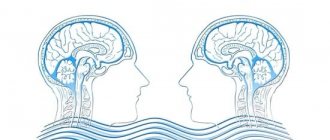History of psychogenetics
The history of the development of psychogenetics can be divided into five stages:
- Development of basic variational and statistical approaches.
- development of basic methods of psychogenetics - twins, adopted children, methods of correlation and regression analysis, path analysis, etc.
- Exploring the role of heredity and environment in individual differences in intelligence and mental illness.
- Improve the methodology of psychogenetics and find new ways of research.
- develop the Human Genome Project.
The basis for the emergence of psychogenetics as a science was the theory of evolution of Charles Darwin.
Francis Galton is considered the author of the first scientific study on psychogenetics ("Hereditary Genius", 1869) and the founder of psychogenetics.
1. At the first stage (1865-1900s), Galton and his student K. Pearson developed the main variation-statistical approaches to the study of the heredity of quantitative human traits (including psychological ones).
2. At the second stage (until the end of the 1930s), the main methods of psychogenetics were twins, adopted children, methods of correlation and regression analysis, path analysis, etc. — was finally formed thanks to the joint efforts of geneticists, psychologists, and mathematicians. With the development of psychodiagnostics in psychogenetics, the accumulation of factual material began.
3. The third stage (until the end of the 60s) is characterized by extensive development. Factual material is being accumulated. Much attention is paid to studying the role of heredity and environment in individual variability in intelligence and mental illness.
4. At the fourth stage (by the end of the 1980s), psychogenetics again pays significant attention to improving the methodology of science and finding new ways to conduct research. Improvements in information technology have contributed to the use of computer modeling methods. The study of the role of heredity and environment in development, including various types of developmental disorders, is becoming increasingly dominant. Longitudinal studies are becoming increasingly popular, and various aspects of environmental influences are being analyzed in more detail.
5. The fifth phase (from the 1990s to the present) coincides with the intensive development of the human genome project.
The genome is the totality of genetic material contained in the cell of any living organism. A cell is an elementary unit of structure and vital activity of all living organisms (with the exception of viruses, which are often classified as non-cellular forms of life), which has its own metabolism and is capable of independent existence, self-reproduction and development. All tissues of living organisms either consist of many cells, as in multicellular animals, plants and fungi, or are single-celled organisms, as in many protozoa and bacteria.
The genome contains the biological information necessary to create and maintain an organism. Most genomes, including the human genome and the genomes of all other cellular life forms, are made of DNA, but some viruses have genomes made of RNA.
There is also another definition of the term “genome”, in which the genome is understood as the totality of the genetic material of the haploid set of chromosomes of a given species.
The haploid set (Greek gaploos - one, eidos - species) is the normal number of chromosomes in each gamete (in humans it is 23, until recently it was believed to be 24).
Gametes are reproductive cells that have a haploid (single) set of chromosomes and participate in gametic, especially sexual, reproduction.
Eukaryotes, or cores, are a region (superset) of living organisms whose cells contain a nucleus.
All organisms, with the exception of prokaryotes (bacteria and archaea), are nucleated.
What tasks does psychogenetics perform?
- Determines the role of environment and heredity in the formation of a person’s personality.
- Determines the elements of the environment that have the greatest contribution to the development of a particular trait.
- Studies environmental parameters in shaping human behavior.
As you can see, this is not a simple science, with very serious tasks, which in one way or another come down to studying the environment in which a person grows up. But science also does not deny the enormous contribution to a person’s individuality, which is determined by genetic characteristics. Let's focus on individuality.
Methodology of psychogenetics
The methodological capabilities of psychogenetics are limited:
- Impossibility of arbitrary experimentation; the object of research is a person;
- late onset of the reproductive period;
- a small number of offspring. However, psychogenetics uses quite professional methods and applies the methods of modern genetics. The main methods of psychogenetics are:
- population method;
- genealogical method;
- foster children method;
- twin method.
Population method. A population is a collection of individuals of a given species living in a given space for a sufficiently long time (a large number of generations), within which one or another degree of panmixia (random formation of parental pairs independent of the genotype and phenotype of individuals) is practically carried out and there are no noticeable insulation barriers.
This population of individuals is separated from neighboring populations of individuals of a given species by some form of isolation pressure.
Man belongs to one of the species of living beings and is characterized by the formation of certain populations.
In addition to biological reasons, various social factors also influence the formation of human populations.
Human populations can vary in size.
The term “population” can be applied not only to the population of cities, but also of entire countries.
For example, with the collapse of the USSR, migration of various population groups from one country to another began.
You can also take Moscow and New York as an example. Where every day a large number of people of different nations and communities inhabiting different places cannot be accommodated in these megacities.
Closed populations are called isolates. Isolates are closed populations.
The influx of external spouses is no more than 1.5 - 2%. Isolates in human populations can occur not only in geographically isolated places, but also within large populations when some groups of people do not mix with the rest of the population, for example, for religious or ethnic reasons.
The prototype is groups of people who live with everyone else but do not mix with them (castes in India).
There is variability in traits in a population; depending on the type of variability, there are 2 types of traits: -Quantitative traits; -Quantitative characteristics; -Quantitative characteristics.
Qualitative (discrete) characters are found in a limited number of variants, the differences between individuals are clearly expressed, and there are no intermediate forms.
External conditions have relatively little influence on their expression. Such characteristics include, for example, blood groups in people.
Quantitative characteristics. Quantitative (continuous) characteristics have continuous variability and constitute the bulk of human behavioral characteristics.
All quantitative traits can be measured, and the requirements for psychological measurements in behavioral genetics remain the same, which psychodiagnostic procedures must meet: -reliability; -reliability; -reality; -reliability; -representativeness.
The genetic structure of populations is one of the most important factors determining the characteristics of the hereditary transmission of various traits.
When studying the mechanisms of inheritance of any human trait, it is necessary to take into account the characteristics of the population being studied.
Genetic changes at the population level are typically analyzed using two mathematical approaches. -deterministic approach -stochastic approach.
The genealogical method is a method of constructing a pedigree - a method of collecting and analyzing pedigrees.
The purpose of the method: -Determination of the heredity of a trait; Determination of the type of inheritance of a trait (autosomal, sex-linked, dominant, recessive); - identification of persons, carriers; -Determining the prognosis of offspring.
“It is based on simple logic: if any trait is encoded in genes, then the closer the family ties (that is, the more similar the genes), the more these people should be similar to each other in this trait.
Psychogenetics as a field of modern science
Let's start with a standard definition: psychogenetics is a science that arose at the intersection of genetics and psychology and studies the role of heredity and environment in the formation of human psychophysiological properties, the relationship between genotype (features that are transmitted to a person genetically) and phenotype (acquired in the process life personal characteristics). There is an option: psychogenetics is a science also called genophysics and owes its development not only to genetics and psychology, but also to physics! What is unique is that in some countries of the world it is believed that psychogenetics can provide simple and accessible life advice on how to feel happy, prosperous and healthy.
Abroad they prefer to talk about the genetics of human behavior (behavioral genetics). The purpose of the study is to try to find out how genetic and environmental factors are involved in the formation of the phenotype. One thing is almost clear: the term “behavior genetics” is not entirely adequate, since the unit of behavior analysis is still, we see, an act, and it cannot be considered a sign in the genetic sense of the word, and, in turn, mental properties studied by psychogenetics (intelligence quotient, temperament, etc.) are not behavior. Of course, you can judge a person’s behavior from the outside by analyzing it - hence the understanding and assessment of memory, intelligence, temperament, will... Peculiarities of human behavior or mental properties represent special signs of the phenotype. But it is precisely the psychogenetic analysis of behavior that is extremely complex also because for a person the participation of the environment in the formation of the phenotype is not simply in the influence “here and now” - the environment is not only the physical environment, but is manifested in complex and diverse cultural and social influences, each of which has its own history.
When defining the range of problems of psychogenetics as a science, it is worth mentioning the relatively recently appeared term behavioral genomics - a term introduced to designate the psychological level of analysis of the work of genes (2000). It arose by analogy with functional genomics, which studies the features of gene functioning at the molecular level, including the interaction of the products of gene activity - proteins. There is also a term for the concept of protein genomics – “proteomics”. Proteomics solves a complex problem, since it is already quite clear that even after the processes of transcription and translation, the information encoded in genes undergoes serious modifications. True, let us say that new, increasingly effective research methods are also emerging: techniques have been developed that make it possible to “turn off” certain genes or, conversely, include them in the genome and study the consequences of these manipulations; Today it is possible to evaluate the expression of a large number of genes in certain areas of the brain after certain events. So, functional genomics tries to establish how a gene works, what its activity leads to and how it is realized in the phenotype, and behavioral genomics is a direction of research that comes from the level of behavior. To understand how genes work, it is necessary to establish how genetic effects interact and correlate with environmental influences, individual experience, what contribution gene influences have on the course of development, how they influence behavior and various types of psychopathology - and these are the main questions of behavioral genomics (besides estimates of heritability of certain psychological properties).
Psychologists once believed that the characteristics of human behavior are almost entirely determined by the influences of the environment in which development occurs. Psychogenetics drew attention to the nature of individual differences in humans (modern differential psychology today is unthinkable without a psychogenetic approach) - absolutely identical influences can lead not to an increase in similarity, but to the emergence of a significant number of differences between people, different genotypes under the influence of the same environmental influences can form different phenotypes .
Psychogenetics has significantly influenced developmental and developmental psychology, forcing us to reconsider such traditional positions as the increasing role of environmental influences on the formation of personality traits as we grow older. And the importance of environmental influences on the formation of properties common to members of the same family has been questioned - as a result of the study of psychogenetic data, it becomes known that the same environmental influences are experienced differently by family members and can lead to differences in many mental traits. And in general, it is likely that a simple separation of genetic and environmental influences is practically impossible in some cases: the genotype can actively interact with the environment (to the point that environmental influences themselves, to some extent, become predetermined by the characteristics of the genotype). Detection of genotype-environment interactions and determination of their role in the formation of behavior is one of the most important tasks of psychogenetics.
So, for all psychology, the importance of psychogenetics is determined by the fact that it makes it possible to clarify the role of environmental influences in the development of certain personality characteristics and helps to identify those components of the environment that can really influence the formation of the characteristics of a person’s behavior and the properties of his psyche. When planning psychological experiments, it is worth considering ways to separate the effects of the environment on the individual from the influences of the individual on the environment (it must be taken into account that there is a large amount of data showing very strong individual differences in reactions to environmental influences. And often environmental influences, which are, for example, a risk factor the occurrence of any pathology are most clearly manifested in those individuals who have a genetically determined predisposition). Let us note right away that there are differences in the approaches of psychogenetics and sociobiology. Sociobiology uses the achievements of ethology (the science of animal behavior in natural conditions, mainly genetically determined) to explain human social behavior. She compares the social behavior of animals and humans and finds similarities in certain mechanisms. The most common approach here is to compare behavioral patterns in human populations that differ sharply in cultural traditions. For example, the ability to smile or raise eyebrows when surprised is common to all human populations. It is natural to believe that such behavior is genetically determined, that there are genetically controlled repertoires of behavior. However, it is hardly worth transferring these conclusions to most aspects of behavior, as well as exaggerating the role of restrictions imposed by biology on social processes in humans. Psychogenetics, in contrast to human sociobiology, studies not the similarity of behavior in different populations, but individual human differences in the same populations - the subject of psychogenetics is the nature of individual human differences. Let us also add: psychogenetics studies primarily those mental and psychophysical properties of a person that can be reliably assessed and studied. In particular, the subject of research in our science, as is already clear from the previous text, often becomes the heritability and variability of deviant forms of behavior; mental illness; types of temperament; types of brain rhythms.
Right away, looking ahead a little, let’s say: the main method of psychogenetics is the twin method. He proceeds from the fact that only monozygotic twins have an identical set of genes and, therefore, in a situation of identical environmental conditions, the similarity within the pair should be greater than that of dizygotic twins. This method also explores the individual characteristics of people who are genetically identical, but brought up in different environments (the study of separated monozygotic twins). However, only combining the results obtained by different methods (there are also population, genealogical, adopted children methods, etc.) provides the most reliable information about the role and relationship of genetic and environmental components in the formation of human psychological characteristics.
• Genealogical method – study of similarities between relatives in different generations.
This requires accurate knowledge of a number of characteristics of direct relatives on the maternal and paternal lines and coverage of the widest possible range of blood relatives. It is also possible to use data from a sufficient number of different families to reveal similarities in pedigrees. This method is mainly used in medical genetics and anthropology. However, the similarity of generations in terms of psychological characteristics can be explained not only by their genetic transmission, but also by social continuity.
• The population method allows us to study the distribution of individual genes or chromosomal abnormalities in human populations.
To analyze the genetic structure of a population, it is necessary to examine a large group of individuals, which must be representative, that is, representative, allowing one to judge the population as a whole. This method is more informative when studying various forms of hereditary pathology.
- Analysis of the heritability of normal psychological traits - this method, taken in isolation from others, does not provide reliable information, because differences between populations in the distribution of a particular psychological trait can be caused by social reasons, customs, etc.
- The method of adopted children is a comparison of similarities on some psychological basis between a child and his biological parents, on the one hand, and the child and the adoptive parents who raised him, on the other.
All methods require mandatory statistical processing specific to each method. The most informative methods of mathematical analysis require the simultaneous use of at least the first two methods.
It is necessary to say something about such new branches of science as genetic psychophysiology and genetics of individual development.
Now let's return to the history of science. In the mid-50s of the XX century. There was a meeting between physicist engineer Champion Teutsch, who served in the war as a combat US air intelligence officer, and Joel Marie Noel, gifted with psychic abilities. In their endless conversations and debates, a new amazing science and/or practice was created - psychogenetics.
Before meeting Joel Champion, Teutsch persistently sought a means of explaining human behavior and ways to change it for the better: he studied the recognized classical directions of psychoanalysis and psychotherapy 3. Freud, C. Jung, B. Skinner, and studied cases of sporadic spiritual healing. However, psychoanalysts did not satisfy him, because the client’s healing process was long and unstable, and unique isolated cases lacked rationality and logic - their randomness and scientific groundlessness were simply alarming. However, the situation changed when D. Noel, who had a supernatural gift to influence the subconscious of clients and faith in the truth of goodness, the perfection of life and the ability to spiritually and psychologically change illnesses, failures, disappointments into positive states, showed her skills to Toich. What united them? Love, work, a miracle of communication and a miracle of abilities? Together they coped with cases in which traditional methods were powerless. They created a natural scientific basis for a new direction of psychotherapy associated with spiritual healing, and their concept was discussed and then received recognition in universities, clinics, and scientific symposia in many countries around the world.
Let’s try to understand the main idea of the creators of our scientific discipline: the genetic code, even before a person’s birth, determines most of his life prospects and almost all basic patterns of behavior (!). Information about the experiences of ancestors is stored along with information about appearance in the DNA molecule. Each person has a core internal direction, a unique combination of genetic, unconscious and conscious factors, according to which he moves through life, experiences and plays social roles - regardless of his own conscious reactions and interpretations. The vector of the main internal direction affects human behavior, success, and health.
Unconscious expectations, secret, dormant hostility for the time being, guilt, fear or the desire for death also attract potential partners. It is with them that man lives, wandering through the labyrinths of misunderstanding, illness and hatred, in the circles of, so to speak, hell. And nothing can be corrected by solving only specific problems, as is done in classical and modern directions of psychotherapy - in the biography of a person or his descendants, conflicts will be played out again and again - until his main life direction is changed. Psychogenetics states: until we ourselves are aware of the negative programs of our genetic code, we will, for the most part, remain victims of circumstances, chance encounters, and someone’s ill will. Awareness of the negative aspects of your genetic program helps you become masters of your life and create a new present and future well-being with your own hands, mind and will. Dr. Teutsch constructs a genogram, showing the causes and common roots of past experiences, the current situation and the future direction of development. A few sessions are usually enough to achieve significant progress in the client’s affairs... But all this is from the field of practice, pseudo-scientific theorizing, pop psychology, adventures of the mind and emotions in the vastness of the American prairies and skyscrapers...
Like every science, psychogenetics, the foundations of which we study, also has its own real history, complicated, confusing, sometimes versioned, and yet...
Formal-dynamic characteristics of personality and individuality! Today these include emotionality and abilities, reactions and behavior patterns, and much more, which is well known to specialists. Moreover, all this is actually diagnosed: according to the characteristics of behavior in existing or specially simulated life situations. We are different! The ancient Egyptians and Babylonians valued the position of a scribe very highly, but the tests were quite tough - applicants had to have many mandatory professionally significant qualities (by the way, those who did not pass the tests were not allowed again). Egyptian priests chose successors not only from their own families - all applicants underwent difficult trials. Ancient China left evidence of testing knowledge, skills and reactions to what was happening - and officials knew how to create a situation! The legendary scientist and magician Pythagoras attached great importance to how a young man entering his school behaves in emotionally intense moments that were specially created for them - how he reacts to ridicule and even bullying, how he behaves in public, how he communicates. A person’s character, Pythagoras believed, is manifested in both gait and laughter - by the way, the manner of laughing, from his point of view, is the best assistant in discovering character traits. The great Theophrastus described 30 bright characterological types and their specific manifestations. Scientists believe that Hippocrates, Aristotle, and Galen spoke about a large number of informative indicators that we now use in psychodiagnostics. Medieval scientists of the East - Avicenna, Al Biruni and others develop the thoughts of their great teachers and predecessors.
Since Antiquity, one way or another, there has been physiognomy - the doctrine of recognizing natural individual characteristics (character) based on the physical characteristics of a person, his appearance.
What about the handwriting? This is also an external manifestation, but what? The history of graphology dates back to ancient times and the first statements about the connection between handwriting and personality can be found in the works of Aristotle, Theophrastus, and others already listed above.
Actually, the beginning of the empirical, pre-scientific stage of development of graphology is usually associated with the appearance in 1622 of the work of the Italian C. Baldo, “Discourses on the way to recognize the customs and qualities of a writer from his letter.”
In the XVIII–XIX centuries. In France, Italy, Germany and Russia, there is a growing interest in the relationship between handwriting and the psychological characteristics of a person. Graphology is of interest to I. Goethe and C. Darwin, A. Humboldt, A. Dumas fils, J. Sand, W. Scott, Edgar Allan Poe, and later V. Solovyov, A. P. Chekhov and others. J. V. Goethe wrote : “Handwriting is directly connected with the whole being of a person, with the conditions of his life, work, with his nervous system, therefore our manner of writing bears the same undoubted material stamp of individuality as everything with which we come into contact.”
J. I. Michon is considered the founder of graphology as a science. In 1871, he made the first attempts to systematize the characteristic features of handwriting. He also coined the term graphology. Michon believed that handwriting contains features, each of which has a basic meaning indicating a personality trait. He was convinced that a graphically expressed and graphologically assessed trait leads directly and unambiguously to one or another personality trait. In the book “Secrets of Writing,” Michon noted the need to widely use graphology in the examination of writing. He believed that graphology should attract the attention of judicial workers to judge the nature of the accused, and he himself was involved as an expert to establish authorship. At the initiative of Michon, at the end of the 19th century, graphological societies were formed and special journals on graphology began to be published.
Issues of graphology were also covered in the works of C. Lombroso. In his opinion, the handwriting of a born criminal is characterized by special graphological features that indicate the hereditary criminal inclinations of their owner. Later, in Soviet criminology, Lombroso's anthropological direction was considered reactionary.
Biologist V. Preyer studied the physiology, psychology and pathology of writing, and experimented with writing under hypnosis. He suggested to a person under hypnosis that he was cunning, secretive, etc., and at the same time forced him to write from dictation. As a result, the handwriting in each case was different, completely different from the handwriting of a given person in his usual state and contained features interpreted by graphologists as signs of secrecy, cunning, etc. For example, the property of stinginess in handwriting is characterized by compressed writing, almost no or very little margins. small, etc.
A special role in graphological science belongs to L. Klages, who proceeded from the fact that a person’s character is reflected in any of his movements. Writing is a projection of consciousness in the form of various fixed movements, and handwriting is a fixed trace of movements and it should reflect the individual character of a person, which predetermines the individuality of handwriting. Movements when writing are automated, therefore they naturally express the internal impulses of a person, which can be recognized by such parameters of movements as speed, strength, rhythm, etc. L. Klages believed that the nature of each sign of handwriting is dual (later graphologists recognized it as polysemantic), and each sign has a negative and positive meaning.
Experimental psychology, which emerged in the mid-19th century, aimed to understand the general patterns of human behavior. Individual characteristics, as deviations from basic patterns, were considered as a hindrance, a source of inaccuracy in the description. A recognized authority in the field of differential psychology, A. Anastasi, believed that this attitude was reflected even in terminology: it was from the first experimental psychologists that we inherited the term “error,” used to denote a deviation from the average value (for example, “standard error”).
But the beginning of the scientific study of individuality is associated primarily with the names of the English scientist Francis Galton and the German scientist William Stern.
F. Galton was the first to make individual differences between people a special subject of study, created measurement procedures and the initial statistical apparatus for assessing differences; collected a large amount of experimental material concerning, as we would now say, different levels in the structure of individuality - somatic, physiological, psychological. Galton raised the question of the origin of individual characteristics and tried to solve it.
In 1900, V. Stern, in the book “On the Psychology of Individual Differences (Ideas for Differential Psychology),” first introduced the term “differential psychology” to designate a new field, “emancipated,” in his words, from its mother science – general psychology . The methodological and experimental approaches, basic concepts, and many statistical techniques formulated by Stern, despite the passage of almost 100-odd years, are still true today.
Let us assume that all of the above is the historical outline of our science - psychogenetics (it should be noted that in modern foreign scientific literature, which is published mainly in English, the term psychogenetics is practically not used - to designate this scientific discipline the name genetics of human behavior is usually used behavioral genetics). Some time ago, in the German-language scientific literature, one could also find other designations - in 1969, a manual on human genetics was published edited by P. Becker, one of the chapters of which was called Humangenetische Psychologic, which can be translated into Russian as psychogenetics. In 1982, a book by the German psychogeneticist F. Weiss was published, in which the area of knowledge that interests us is clearly designated as psychogenetik. In Russian psychology, the name psychogenetics has been firmly established to denote our discipline in higher education, although, as we said above, you can find the terms behavioral genetics or human behavior genetics, which are used interchangeably.
The “Big Explanatory Psychological Dictionary,” published in Russian in 2001, defines behavior as a generic term covering actions, activities, reactions, movements, processes, operations, etc., i.e., any measurable (emphasis added ) body reaction. But I. V. Ravich-Shcherbo, one of the leading psychologists, founder of the first psychogenetics laboratory in our country, emphasizes the inappropriateness of identifying all psychology with the science of behavior and believes that the field of knowledge that could be called psychological genetics is more correctly called psychogenetics , and not the genetics of human behavior, as is common in the West. We see that in our country our science is not always designated in the same way. In general, with the modern level of integration of science, one should adopt a designation that is generally accepted, so as not to speak different languages, however, for internal use, the familiar term psychogenetics should still be preserved, but it should be clearly agreed upon what content will stand behind this name.
Genealogical method
The genealogical method is a method of compiling a pedigree - a method of collecting and analyzing family trees.
The purpose of the method is to: -Determine the heritability of a trait; Determine the type of inheritance of the trait (autosomal, sex-linked, dominant, recessive); -Identify people, carriers; -Determine the prognosis of the offspring.
“It is based on simple logic: if any trait is encoded in genes, then the closer the family ties (that is, the more similar the genes), the more similar these people should be in this trait. Therefore, a necessary condition for using the genealogical method is the presence of relatives of the first degree, forming the so-called nuclear family; This includes parent-child and sibling pairs;
- these, and only these, share on average 50% of their genes. Moreover, as the degree of relatedness decreases, the proportion of common genes decreases, and, according to the scheme of the method, the similarity of people should decrease.
The more generations the family tree includes and the larger the circle of relatives, that is, the more extensive it is, the more reliable the results should be.
There are certain rules and symbols for drawing up family trees.
The person for whom a genealogy is created (for example, with a rare ability or, in medical genetics, with a suspected hereditary disease) is called a proband.
The members of the family tree are arranged in generational order, indicated by Roman numerals on the left side of the page where appropriate: -Previous generations to subsequent generations; -Children in each family are from left to right according to birth order, they are indicated either by numbers or by age. For some tasks, such as psychotherapy, it is important to know the types of dyadic relationships in addition to related ones; then they can also be noted on the family tree.
Some researchers suggest calling this drawing a genogram.
A genogram is a format for representing a family tree by recording information about family members and their relationships over at least three generations. The genogram graphically represents family information in a way that creates a picture of a complex family pattern and provides an additional source of clues about how the clinical problem may be related to the family context and the dynamics of one and the other over time.” Textbook of psychogenetics /I. V. Ravich-Scherbo.
The adopted children method is a comparison of the similarities in certain psychological characteristics between a child and his biological parents, on the one hand, and the child and the adoptive parents who raised him, on the other.
On the one hand, this method has rather narrow boundaries: -legal -Psychological. -Possibility of non-random distribution of children among families; -Subjective “legends” about parents/adoptive parents.
However, despite the disadvantages, this method has some advantages in psychogenetics. First, it is theoretically the purest method with the highest resolution.
Foster care research involves children who are placed as early as possible with foster parents who are strangers—the foster parents, their biological parents, and their adoptive parents.
A variation of the adopted children method is the study of so-called adopted (fused) siblings, that is, several non-biological children adopted by the same family.
There are two schemes of this method: - full scheme. -partial diagram.
The full scheme combines data from two groups: -the scheme for separated relatives (biological parents and their brothers and sisters); -sibling diagram.
A partial schema combines either one or another group of data. The method of adopted children is one of the main methods of modern psychogenetics.
Concept of individuality
Scientist B.G. placed great importance on this definition. Ananyev. As he wrote in his works: “Individuality is the product of the merging of the social and biological in the individual development of a person.”
It's hard to argue with that. Have you ever thought about why all people are so different? Even children in the same family are not repeatable individuals. What is this connected with? Yes, the parents can be the same. But the conditions in which children grow up may differ. Even the fact that one child appeared when the parents were 20 years old and had one status, and the second 5 years later, and mom and dad became different, social conditions changed, affects the development of the individual.
Since psychogenetics is a science, it has its own methods. Let's look at them below.









